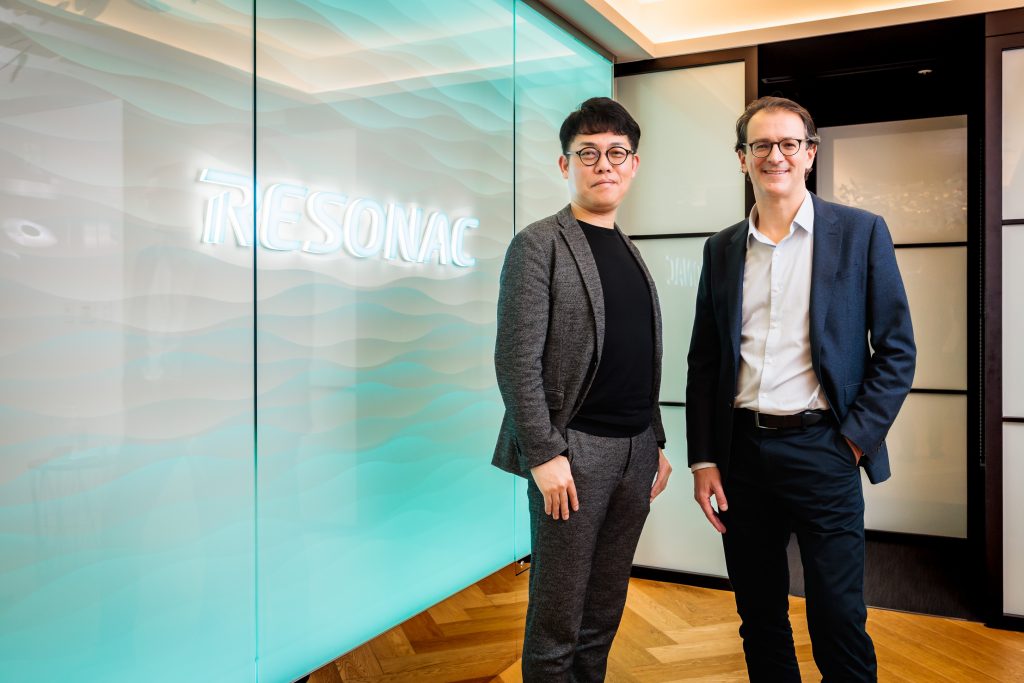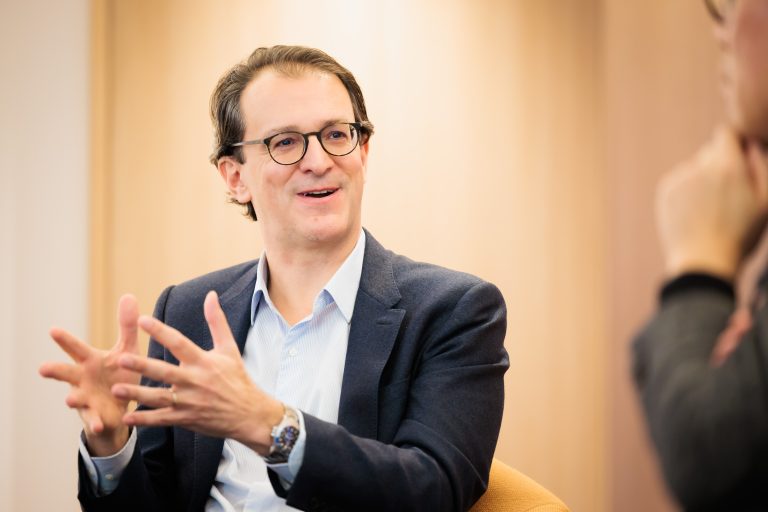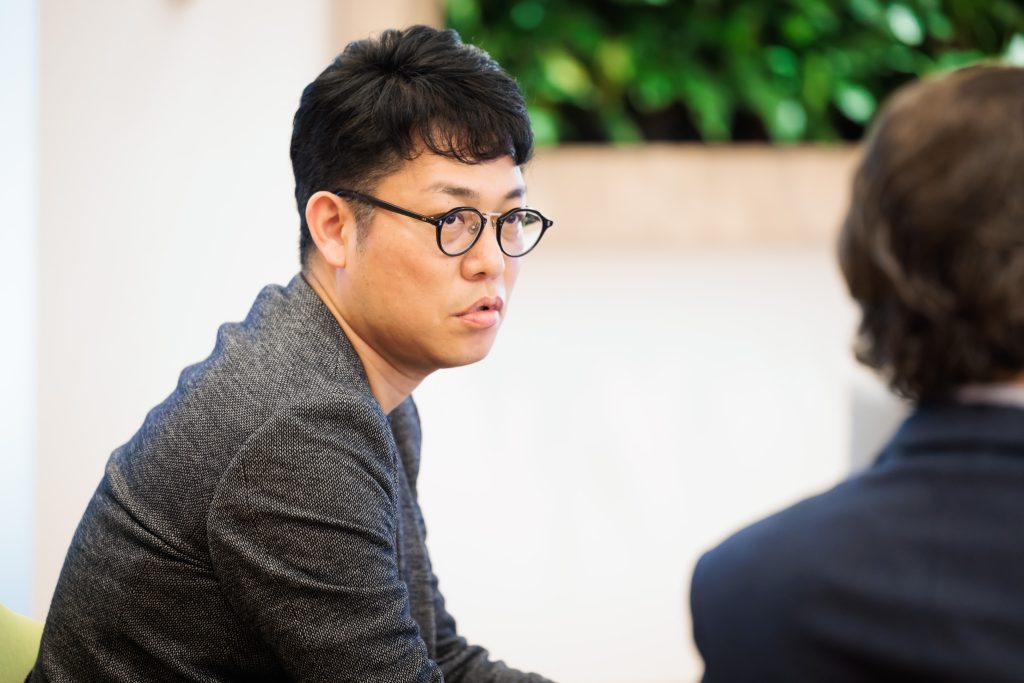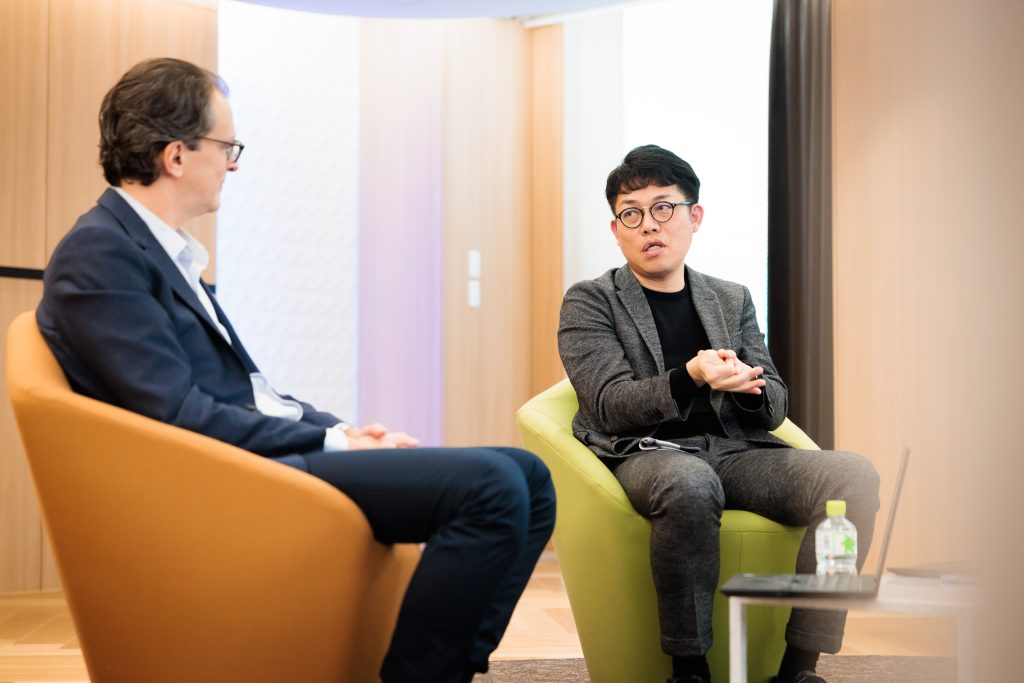A MARKETONE INTERVIEW
You may think that marketing in Europe and the US is broadly similar to how it’s done in Japan. But many Japanese companies, particularly in the manufacturing industry, often face challenges in securing the necessary assets and gaining internal support to drive their global marketing initiatives.
In this interview, Enrico Brosio, President of MarketOne International talks to Ryoichi Takeuchi, Global Digital Marketing Manager of Japan’s Resonac Corporation. Resonac is currently a client of MarketOne Japan.

Drawing on examples from advanced global marketing, they discuss the necessary steps and stages to establish a marketing model that is best suited to their company. They started off by introducing themselves and providing an overview of their organization.
Takeuchi: I’m Ryoichi Takeuchi from Resonac Corporation. Resonac was established in January 2023 through the merger of Showa Denko and Showa Denko Materials (formerly Hitachi Chemical). I lead the Platform Group within the Corporate Marketing Department, overseeing the activities of the Digital Marketing team and CRM team. We’ve been expanding our digital marketing activities within the company since 2016, and it has been an ongoing effort.

Brosio: I’m Enrico Brosio, President of MarketOne International. Based in London, among other things I’m responsible for corporate and business development outside of Japan. Our clients and our company are constantly experimenting and innovating on the front line of global marketing. Today is a very valuable opportunity to get inspired by engaging in a conversation around the expansion of a global marketing practice from Japan. Thank you for the opportunity!
Takeuchi: Thank you. What kind of services does MarketOne offer outside of Japan?
Brosio: Like MarketOne Japan, we exclusively focus on providing services for B2B companies. Many of our clients are in the IT or manufacturing industries, and they’re led by global CMOs who handle a wide range of activities from branding to customer experience to demand generation. A significant portion of our marketing activities is multinational in nature. I’d like to congratulate you on the fresh rebranding of your company. How do you envision the future development of marketing?
Takeuchi: Thank you. As a CMO organization, we create a rolling plan envisioning where we want to be in five years’ time. Our goal for 2022 to 2027 is to generate new projects that contribute to our sustainable growth. We call this Potential Opportunity Analysis (POA). Last year, we generated projects that led to new business worth tens of billions of yen. However, our goal is to double that number and create twice as many new projects in five years.
Brosio: Doubling it in five years! That’s an exciting plan. In order to achieve that, a significant transformation in marketing activities seems necessary, wouldn’t you agree?
Takeuchi: Absolutely. For that purpose, we need to expand our activities in such regions as North America, Europe and ASEAN, and strengthen our presence in Japan. When it comes to international operations, we’re pursuing the idea of building a strong self-driving organizational structure in each country, rather than relying solely on top-down control.
We’ve classified our marketing activities and defined five levels, ranging from Level 1 to Level 5, and categorized each country accordingly. Currently, Japan is classified as Level 4, where we can create our own content. Our aim is to elevate both domestic and international digital marketing teams to Level 5 by 2027. It is a challenging goal, but we believe it is necessary to double the projects we have in 2022.
Resonac’s Digital Marketing Level Definition
Level 1: Utilizing localized versions of content, with Japanese support for newsletter distribution.
Level 2: Applying Japanese content locally, capable of self-driven newsletter distribution.
Level 3: Implementing marketing initiatives using a mix of newsletters and multiple channels.
Level 4: Consolidating Value Propositions locally and creating content, implementing multiple initiatives to achieve KPIs.
Level 5: Self-driven implementation of multiple marketing initiatives, conducting PDCA cycles based on data utilization.
Brosio: I see. The level classification serves as a metric for maturing marketing organizations in each country. It provides a clear understanding of the current state and the desired end point. When expanding globally on that scale, do you think a transformation in digital platforms is also necessary?

Takeuchi: That’s right. In our company, we use Oracle Eloqua as our marketing automation (MA) platform. Since we started collaborating with MarketOne last summer for global expansion, your company has provided us with various templates and offered more efficient processes. Currently, we are working on building an ‘always on’ approach to have contact with customers throughout their lifecycle. Looking ahead to growth over the next five years, we must go beyond the framework of ‘efficiency tools’ and use them more as a foundation for business creation.
Brosio: What are your thoughts on changing and transforming the goals and objectives of the marketing department?
Takeuchi: We have set a lofty goal of doubling the number of new business projects compared to 2022 as our Key Goal Indicator (KGI) for 2027. But that’s simply a KGI and I think the important thing is how to reach that goal. To achieve our targets, it’s crucial not only to support the marketing teams overseas but also to collaborate with stakeholders within the company who are not directly involved in marketing. Understanding the multifaceted challenges faced by various business units, sales departments, and R&D personnel in promoting products and marketing activities, and gradually solving each issue while persistently advancing our activities, becomes essential for achieving the set KGI. Being present in the actual field with them, understanding the problems first-hand, is the path to becoming a better marketer trusted by internal stakeholders.
Brosio: You’re talking about a marketing function in various locations, building a self-driven organization that aligns with corporate, and fostering understanding with internal stakeholders. It’s a wonderful approach that leverages Japan’s strength in valuing sustainability.
Takeuchi: I’m interested to hear more about how European and American companies approach global marketing. I believe MarketOne is working with a European global manufacturing company with 200 marketing staff across the globe that is considered a good benchmark. Can you share with me its goals and missions?
Brosio: This company has marketing teams in 80 countries who are divided into two groups based on their maturity level. One group operates independently, while the other group utilizes support from MarketOne. Like Resonac, they classify the skill levels of their marketing teams in each country from level 1 to 5, and the headquarters provides support through MarketOne based on the assigned levels.
Reporting to their head office, our main focus is on marketing automation platform governance and managing its usage. Our solution is based around our ‘follow the sun’ global resource model and our combined offering of production services and strategic advisory.
Takeuchi: Which marketing automation tool do they use?
Brosio: They use Marketo. They place a strong emphasis on having continuous customer touchpoints and providing customers with better experiences throughout their customer journey. They constantly strive to increase the number of contacts in their own database, which serves as the foundation for digital marketing. Starting with that database, we design the customer journey, incorporating not only email but also external media channels.
In addition to the team responsible for designing marketing campaigns, there is also a team specialized in tool and data management. Despite being a non-English-speaking company, they have implemented global marketing by creating basic content in English, making it easier to localize into various languages. They’ve established measures to promote and manage global marketing. A team called Center of Excellence (CoE) is responsible for driving global marketing, and MarketOne is responsible for promoting global marketing as a member of this CoE team.
Takeuchi: What does this organization set as intermediate indicators to achieve global KGI?
Brosio: In this company, to achieve the top-down given KGI, they have set four KPIs. The 1st one is to increase the number of marketable (opted-in) contacts. The 2nd is to increase the average monthly active users (contacts that respond to campaigns). The 3rd is pipeline generation, and the 4th is the number of closed deals. There are differences in brand awareness and content volume between the headquarters in Europe and other regions. Considering these factors, they set individual KGIs for each region. In regions with weaker brand power, they use Account-Based Marketing (ABM) and social networking sites like LinkedIn, which do not require extensive brand awareness. They implement initiatives that directly approach key individuals to achieve the KGI.
Takeuchi: I see. At Resonac, we define sample requests from customers as Sales Qualified Leads (SQL), which is an important KPI linked to KGI, and a quantity of sample requests leads to new business opportunities. By analyzing the conversion rate from SQL to new business opportunities and identifying the causes, we continuously make efforts to increase the conversion rate.

Brosio: That’s a fantastic approach. It’s crucial to calculate and leverage the conversion rate in marketing activities, not only for improving cost-effectiveness but also for determining how many SQLs are needed to achieve the revenue-based KGI.
Takeuchi: Let me give you an example. Suppose the marketing KGI is to contribute 1 billion yen in revenue. Assuming the average value per deal is 10 million yen, to achieve the 1 billion yen KGI, 100 deals would be required. If the conversion rate from quote submission to deal closure is 50%, then 200 quote submissions would be needed to achieve the KGI. Furthermore, to generate 200 quote submissions, 500 negotiations would be necessary, and to generate 500 negotiations, 2,000 contacts would be needed. By setting KPIs such as the number of deals, quote submissions, negotiations, and contacts to achieve the KGI, it becomes possible to calculate the KPIs required to achieve the KGI.
Brosio: Exactly. For example, even if it costs 10 million yen to exhibit at an event, acquiring 500 new contacts there, which leads to 25% (125) negotiations, and if 40% of those negotiations (50) result in quote submissions, then 50% of those (25) could be potential deals. With 25 closed deals multiplied by the average deal value of 10 million yen, a return of 250 million yen can be expected. If a reproducible conversion rate is anticipated, it becomes possible to consider the amount spent on marketing not as a cost, but as an investment to generate deals. This perspective is referred to as ROMI (Return on Marketing Investment) in Europe and the United States. Reverse engineering thinking is essential for global marketing strategies.
Returning to Resonac, if we assume a POA target in the range of tens of billions of yen and consider sample requests as SQLs, how would you calculate the POA generated from SQLs?
Takeuchi: We receive inquiries from customers, deliver samples, and only when the initial evaluation is positive, do we obtain information regarding their future demand. Based on that, we calculate the aggregate value of the POA. When conducting marketing activities, we hold marketing planning meetings involving all members related to specific products associated with marketing campaigns, such as the sales department and R&D department. We clarify the budget of the business division and the KGI and KPI required to achieve the goals. On the other hand, as the CMO organization, we set KGI internally and adopt a management approach that associates KPIs with SQLs.

Brosio: In your business, you have various products and a very long lead time until orders are received, right? Therefore, it’s not easy to model ROMI like companies that deal with products with a short duration from negotiation to order. However, it is crucial to have a hypothesis-based ROMI and improve its accuracy year by year.
While setting appropriate KPIs is important, aligning the perspective of each stakeholder on increasing the conversion rate between KPIs changes global marketing from controlling ‘what to do’ to controlling ‘what to aim for.’ It also makes it easier to explain the results to other internal stakeholders. So, even though modelling ROMI may be a long journey, having a hypothesis at the starting point with a reverse engineering mindset is highly valuable.
Takeuchi: Your comments are very inspiring. We have always emphasized the conversion rate, but after listening to you today, I realize we need to be more data-driven.
Brosio: In Western companies, it’s not uncommon for top executives recruited externally to be expected to change their previous digital marketing habits in a short period. You can imagine how challenging that can be. Therefore, the opportunity to create and implement strategies from the beginning is fantastic!
Takeuchi: Yes. The first thing we strongly emphasize to our overseas marketing members is that we want marketing planners who understand the challenges of internal stakeholders involved in marketing activities. We ask them to temporarily forget about marketing tools and technology and instead focus on the importance of planning with internal stakeholders and the significance of setting KGI and KPI. While we also place a strong emphasis on technology, we must first plan what we should work on. We want them to become excellent marketers who can gradually learn technology while overseeing the overall picture of marketing campaigns.
Brosio: Absolutely, I think that’s the right way of thinking! If we look at the KPIs of Level 1 countries, we focus on making marketers think about their role rather than technology and understand what is essential for their success in that role.
Takeuchi: Our digital marketing activities have changed dramatically since last year. There are many things we must do to achieve our major goals, but we want to steadily build a strong marketing team and organization in each country. Thank you for today.
Brosio: Thank you so much as well. I look forward to hearing about the progress and evolution!
Summary:
Fostering a common understanding within a company about what marketing should strive for and what constitutes results is essential and more important than focusing on the different methodologies of digital marketing. It’s important for both the organization and management to build a common understanding that marketing is not simply an expense but an investment to achieve goals and is crucial for the company’s growth and development, regardless of its geographical location.
PROFILES:
Enrico Brosio: President of MarketOne International and Managing Director of MarketOne Europe
Brosio joined MarketOne in 2002 and is based in London, leading business operations primarily in the European region. He also drives business development for the entire MarketOne global organization. His expertise lies in ABM-centred multinational B2B marketing practices and advising MarketOne’s high-tech and manufacturing clients.
Ryoichi Takeuchi: Corporate Marketing Department, Platform Group Leader at Resonac Corporation
After working in sales at the Electronics Materials Division of the former Hitachi Chemical, Takeuchi transferred to the marketing department in 2015. Since 2017, he has led the digital marketing team and expanded marketing activities. As the Platform Group Leader since 2022, he is responsible for the continued expansion of digital marketing activities and the penetration of CRM (Salesforce) within the company. He is driving sales and marketing DX for the Resonac Group.

